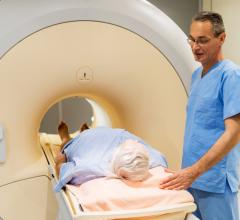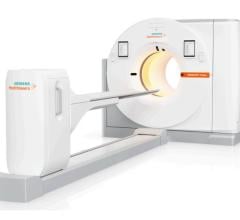
Photo courtesy of Siemens Medical Solutions
Molecular imaging in clinical trials accelerates the development of promising compounds by allowing physicians to see and assess whether a drug is working as intended for a patient.
To put drug development on the fast track, the Society of Nuclear Medicine (SNM) inaugurated the Clinical Trials Network in late 2008 to facilitate more cost-effective drug development through the integration and standardization of imaging biomarkers into Phase 1, 2, 3 and 4 therapeutic clinical trials. As part of this initiative, the society is bringing together pharmaceutical developers, the imaging community, biomarker manufacturers and regulatory agencies to address critical needs for incorporating imaging biomarkers into multicenter trials.
What many clinicians want to know is just how quickly the network will launch its cross-industry research, and what diseases will be targeted first. To find out, Imaging Technology News (ITN) spoke with the chair of SNM’s Clinical Trials Group and past president of the society’s Nuclear Oncology Council, Alexander J.B. (Sandy) McEwan, M.D.
ITN: SNM launched the new Clinical Trials Network to put biomarker development on the fast track. Could you describe in more detail the mission of the program?
Dr. McEwan: It is really to provide a framework to facilitate the use of radiolabeled probes as biomarkers. In the first instance, it’s obviously targeted at trying to help pharmaceutical industry trials. There are a number of reasons for doing this. The first is that there really is a lack of certainty of how to use radiolabeled probes as biomarkers in clinical trials. So whether it’s the pharmaceutical industry or a corporative group study, or ultimately its an in-house study, many of the issues that have plagued FDG in that setting relate to standardization, quality control and quality assurance, and quality imaging sites with those oncology groups who participate in clinical trials. There are real questions to be answered in terms of quantification.
There is no doubt that some of the new targeted biologics are going to require the ability to measure changes in metabolic profile. I think there is some interest in the pharmaceutical industry in using non-FDG probes to help in developing clinical trials with new drugs in terms of learning how to stratisfy patients, measure response and characterize response. So we felt that the right thing to do was, step one, to develop clinical trials. Then look at taking the program further once we have it up and running, and once we have proved our thesis that what we are making it useful.
ITN: Why would the pharmaceutical industry be interested in using non-FDG probes?
Dr. McEwan: FDG measures glucose metabolic rate, which is important, but I think that some of the new targeted pharmaceuticals are going to be in characterizing a receptor, characterizing a transport mechanism, characterizing some internal activity. So, for example, if you take a drug like gemcitabine, something between 20-40 percent of patients with pancreatic cancer respond to it, and 60 percent don’t. We don’t know which do and which don’t. I have a pretty sure idea that we can actually design a probe that will answer that question. So with future drugs, if we know a certain percent respond, then how do we enrich populations to help the clinical trial, and to how do we actually go the FDA or CMS and say we can actually identify the patients that are going to respond. So it is starting this idea of personalized medicine. I think the pharmaceutical industry will be interested because it’s a way to enrich a population, to stratisfy a patient or to characterize a patient population.
ITN: Now, SNM and the International Partnership for Critical Markers of Disease (CMOD) co-hosted a meeting on FDA requirements for manufacturing PET radiopharmaceuticals. Was this tied into the mission of the Clinical Trials Network to put biomarker development on the fast track?
Dr. McEwan: Yes it is. Remember PET pharmaceuticals, and we are talking about fluorine, have to be made on site or within a short shipping distance. So one of the questions is: Does that mean every site is a manufacturing site? We’re hoping that by developing a common IND and manufacturing file, we can facilitate the spread of the technology by those sites that are manufacturing referencing back to our file.
ITN: What are some of the hurdles of developing PET radiopharmaceuticals?
Dr. McEwan: The hurdles are first of all having a manufacturing recipe or file that is consistent and enables quality across multiple sites. The second is ensuring that there is biological equivalence across all of the sites. The next is making sure that you have an appropriate reporting mechanism for audit purposes. Our first plan is to use compounds that have been described to have already been used in man.
ITN: What are some of the major diseases that could benefit from the Clinical Trials Network and the meeting on FDA requirements for manufacturing PET radiopharmaceuticals? You mentioned pancreatic cancer.
Dr. McEwan: I am going to start very broadly and say cancer because it’s going to be very much dependent on the clinical trial that the pharmaceutical company wants to run. So if they have a compound that is against cancer “X,” that would be the one that we would look at. We are not in the position of picking the cancer; what we are doing is facilitating. With FLT it would be cancers that are affecting proliferative capability. So, that will be driven by industry. But it will be cancer first and probably nuerological diseases second, starting with Alzheimer’s disease. But I don’t know.
One of the reasons that FDG is not used routinely in clinical trials is that we have not yet had this type of capacity to facilitate industry trials. By building this capacity we really do see a method to ensure standardization, quality, quality control, quality assurance. What we hope is when this is up and running, it really does become a tool that enables industry and corporative groups to speed trials through, and also to give the FDA some confidence that the quality parameters are really being looked after.
If this had been in place five years ago, FDG might be used much more routinely in the clinical trial setting.
Bio: Alexander J. (Sandy) McEwan, M.D., is the director of oncologic imaging at Cross Cancer Institute, Edmonton, Alberta, Canada. He is a professor and director of the division of oncologic imaging in the oncology department, faculty of medicine, University of Alberta, and is also an honorary member of the associate academic staff of the Faculty of Pharmacy and Pharmaceutical Sciences at the University of Alberta. Dr. McEwan is chair of SNM’s Clinical Trials Group and past president of the society’s Nuclear Oncology Council.


 October 30, 2025
October 30, 2025 









